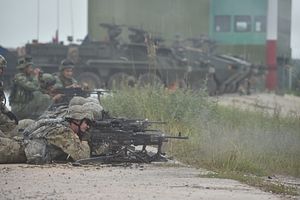From July 17 to July 28, the United States and Singapore conducted the latest iteration of the oldest exercise between their two armies. Tiger Balm 2017, which was by far the largest of these drills to date, was just the latest example of ongoing efforts by both countries to boost their defense ties.
As I have noted before, the United States and Singapore have long viewed each other as vital security partners (See: “Strengthening US-Singapore Strategic Partnership”). For Singapore, the U.S. regional presence has been critical to its emergence as one of the world’s successful economies, and Washington remains a key provider of defense technology and facilities for military training today. For the United States, Singapore has been a regional anchor and an active global contributor, as evidenced by its recent agreement to host littoral combat ships and P-8 Poseidon aircraft as well as its growing role in the global fight against the Islamic State.
Both sides participate in a range of exercises, from bilateral ones like Exercise Red Flag to Exercise Cooperation Afloat Readiness and Training (CARAT) to multilateral ones such as the Cobra Gold exercises and the Rim of the Pacific (RIMPAC) exercises. Some of these exercises have seen advances in recent years as part of a broader strengthening of defense ties, such as CARAT Singapore which starting this year will alternate between Singapore and Guam (See: “US, Singapore to Launch New Military Exercise in Guam”).
This month, both sides conducted the latest iteration of Exercise Tiger Balm, the longest-running bilateral army exercise which has been held in both Singapore and the United States since 1981. The two countries have often cited the two week-long exercise as both a valuable opportunity to collaborate and share tactics and techniques as well as evidence of their long history of cooperation in the security domain.
Last year’s exercise, which saw participation from around 380 personnel from both sides, saw some notable firsts, including the employment of a “Live-Virtual-Constructive” (L-V-C) training approach across the two countries at a large scale, which involved a Combined Arms Live Fire Exercise (CALFX); the employment of the Virtual Battlespace Simulator 2 (VBS2) for surveillance tasks; and the linking of the U.S. Joint Conflict and Tactical Simulation (JCATS) with the Singapore Armed Forces (SAF) Army War-game Simulation System (AWSS) to allow the exchange of ground tactical information.
This year’s exercise was the largest to date by far. According to MINDEF, it involved about 500 personnel from Headquarters 10th Singapore Infantry Brigade and 5th Battalion Singapore Infantry Regiment and 330 personnel from 1st Stryker Brigade Combat Team, 25th Infantry Division from the United States Army Pacific and 29th Infantry Brigade Combat Team from the Hawaii Army National Guard.
This year’s exercise included platoon live-firing as well as a field training exercise, where personnel from both armies conducted missions planned by the brigade command post. A notable first was that this was the first time that US Stryker Combat Vehicles participated in the exercise in Singapore alongside the SAF’s Terrex Infantry Carrier Vehicles.
A number of Singapore’s Terrex vehicles were seized by China last year, compounding anxieties in the region about its arm-twisting of individual Southeast Asian states (See: “Trust Deficit Remains as China Boosts Security Role”).

































